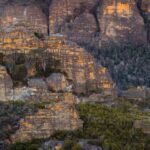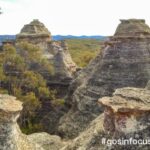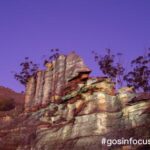Tourism development in protected areas: Are we on the right track?
Bushwalking NSW symposium 19 November 2022
Thank you to our Sponsors:


Summary
Keith gave a stirring call for the protection of nature and for retaining nature intact. See last slide for summary. Also, click here to watch the Symposium video and here to see the Agenda.
Speakers
Andy Macqueen – The Historical Perspective
- the 90 years anniversary of Blue Gum Forest celebration is also a celebration of all national parks and the amazing legacy of Miles Dunphy
- also discussed evolution of the conservation movement
Gary Dunnett, National Parks Association of NSW Executive Officer
- NPA of NSW was established in 1957 to protect nature through community action
- The National Parks Australia Council is concerned about proposals for commercial developments in Protected Areas
- believes Protected Areas Management is veering off track
The findings of the 2021 NPAC national survey of community attitudes on development and commercial activities in Protected Areas reinforced:
- the important protected areas purpose of nature and wildlife protection for current and future generations
- Australians are twice as likely to visit national parks with low impact commercial tours compared to high impact activities
- Any visitor services should be small scale, low key, of value to all visitors, and in keeping with the natural setting
Shadow minister for the Environment, Hon. Penny Sharpe
- Labor’s task is to prioritise environment protection by increasing protected areas, curbing land clearing, establishing market based mechanisms to address climate change and retaining wildlife corridors
- believes national parks have been downgraded – and we need to elevate NPWS status and increase importance of POMS
- said invasive species issues are getting out of hand
Andrew Nicholls PSM, Acting Deputy Secretary, NPWS
- The NPWS acquisition program focus is on under-represented areas of land
- Australia is the world leader in extinctions – 85% of threatened species live in national parks.
- NPWS has a zero extinction policy eg feral animal control, reintroducing locally extinct mammals
- 30% parks estate is managed jointly with traditional custodians
- A key issue is stewarding parks due to increasing visitor demands on parks – the POM is the key tool used to balance conservation and recreation
- NPWS will use existing infrastructure where possible and will develop new camping facilities where needed. Options for those who want to pay more will be available
- Economic benefits from national parks will flow to regional economies
- NPWS will work within national parks legislation using a precautionary approach and consulting with the public
Private Tourism sector perspective from Mark Norek, Life’s an Adventure
- Mark’s sustainable tour business model is to buy land near national parks for infrastructure, use local infrastructure and support local businesses. Accordingly he is adamant that there is no need for development in national parks.
- Outlined how his business principles have been successful with these walks – Bay of Fires, Three Capes Walk, Light to Light and Kangaroo Island
- worried that NPWS is losing their direction and working for the big end of town
University researchers Ali Chauvenet – The Hidden Mental Health costs of the privatisation of parks
- being in nature is good for our health – parks contribute $5000 per person per year in mental health benefits
- without national parks there is double the amount of mental health costs
- parks privatisation increases the gap between those who do and don’t go to parks due to socio economic factors
- there’s a missed opportunity for leveraging funding via mental health benefits but this needs to be inclusive and equitable
- mental ill health is expensive and pervasive
Conservationist perspective from Keith Muir, Wilderness Australia
- Questioned if the next generation will even know how to engage with nature
- Parks development leads to more development and nature destruction not nature appreciation
- Partial privatisation is exclusive beach front development by stealth
- The public are excluded from secret government/developer lease negotiations
- Commercial built development in parks should be legislated against
- Local communities are bypassed and do not receive an economic benefit from high-end development
- Multi use trails are a myth as they displace walkers in place of bikes etc
- Green Gully developments are non-compliant with legislation. Horse riding negatively impacts on wilderness through weed spread
- NPWS conservation role has been diverted to tourism management
- Need to reinforce importance of ecological sustainability – manage parks for nature not humans
Legal perspective from Christopher Birch, SC
- Gave a clear answer to the question: What stops development in National Parks?
- While the PoM is the key instrument, the minister has powers to amend a PoM with only 45 days public viewing eg Beowa PoM was amended to allow hard roof accommodation development
- The minister has extensive powers to grant leases and licences making it very easy to replace NPWS with a commercial operator.
- EPA process: once the PoM is in place, environmental impacts are reviewed. Only have to examine and take into account environmental impacts as The Act doesn’t require impacts to be addressed.
NPWS Greater Sydney Regional Advisory Committee perspective from Brian Everingham
- Preserve Park Protection for Posterity
- Educate younger generations to appreciate that national parks offer more than a backdrop to modern high-tech activities
- More money for weed controls in National/State Parks
- Protect national parks and use existing nearby infrastructure
- Primary purpose of a park is conservation not commerce
- The more we talk together, the stronger we are
- Train young people to guide walks and maintain tracks. NPWS to run these projects and attract more people to walks.
Presentation Summaries:
-
National Parks Association of NSW – Research on development in national parks.
- Brian Everingham, Chair, Greater Sydney Regional Advisory Committee
- Mark Norek, Director, Life’s an Adventure Walking Tours Specialist
- Andrew Nicholls, Executive Director, Business Delivery, NPWS



